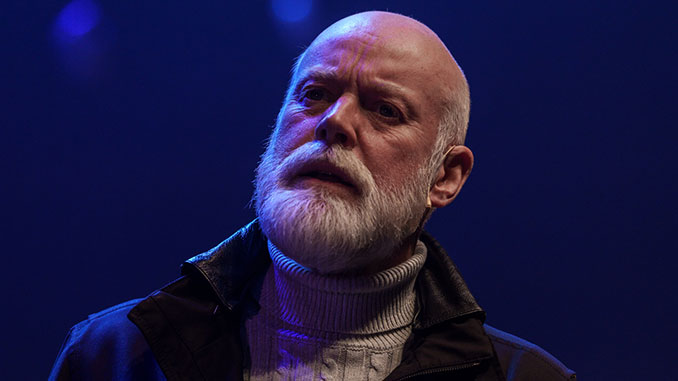 In Act 2 of composer and librettist Maury Yeston’s majestically sweeping and firmly structured musical, Titanic, a run of speculative “if onlys” sing out human nature’s inbuilt response to often unplanned or unexpected circumstances and outcomes.
In Act 2 of composer and librettist Maury Yeston’s majestically sweeping and firmly structured musical, Titanic, a run of speculative “if onlys” sing out human nature’s inbuilt response to often unplanned or unexpected circumstances and outcomes.
It is a reflective and centripetal moment that follows building tension as denial and hope battle a series of irreversible episodes leading to ultimate disaster. Both resultantly and achingly, what lies in the power of Titanic is its musically expressed excellence that makes palpable sunlit hopes and dreams counterbalanced by the darkness of saddening loss and grief.
Based on the story of the world’s largest moving object at the time, RMS Titanic, which sank on its maiden voyage on 15 April 1912, Yeston’s grand 1997 musical in prologue and two acts seems long overdue in a fully staged blockbuster production in Melbourne. If only!
What local musical fans could raise a toast to was the prospect of seeing producer Paul Marrollo’s lavish concert version in a four-performance run on stage at Melbourne Town Hall. And the musical and artistic lineup promised much.
At Saturday’s matinee, Yeston’s richly orchestrated and vividly heaving score of cinematic proportion resonated with great beauty, courtesy of musical director Stephen Gray and his 26 superbly playing musicians spread at the rear.
Most appealingly, Gray took advantage at every turn to mine every phrase contained within music awash with contrasted awe-inspiring scale and delicate, heartfelt romanticism.
Below him, a sprawling ensemble cast of 23 accomplished artists servicing around 40 roles made a director’s challenge a dream. And the voices individually and collectively beamed with affecting strength.
If only Jarrad Gilson’s all-important sound design wasn’t plagued by an unacceptable number of missed cues and mic dropouts on key solo moments. Similarly, sound balance between orchestra and artists took almost half of the first act to settle comfortably – altogether disappointing for what could have been an entirely praiseworthy concert.
With the ornate timber panelled rear stage wall and soaring organ pipes lending a small dose of evocative assistance to the overall effect, director Theresa Borg’s engagingly active and sensitively detailed realisation of broad tableaux and simultaneously occurring vignettes provided consistent interest.
No more than a ship’s wheel, a telegraph operator’s desk and a stepped stage area created Borg’s ocean liner setting. Contemporary costuming cleverly alluded to, without recreating, the story’s era and the finishing touches of Jason Bovaird’s long streams of dramatic lighting added much, including a simply resolved projection of fragmented light in a symbolic nod to the ship’s approach to the iceberg.
Given the dozens of characters on board written into the libretto and Yeston eschewing focus on any sole or starring pair – as director James Cameron did in creating the two protagonists Jack and Rose in the film, Titanic, coincidentally released in the same year – character development might seem thin, yet Yeston achieves much in the collective realm.
Titanic, importantly, is not intended to be about any one’s particular story. That may be so but several soloists in particular gave the complete package with stand-out performances that deserve mention.
Veteran musical theatre star Anthony Warlow received warm applause when he stepped out as Captain E.J. Smith, portraying a commanding, compromised and distinguished individual who had come out of retirement to take responsibility for more than two thousand souls.
Juan Jackson acted out ship designer Thomas Andrews’ fast-increasing burdens with total belief in penetrating and authoritative voice, doubling as announcer of time and place. Kane Alexander turned up the dial on ugly self-entitlement and obnoxiousness as the director of the White Star Line, J. Bruce Ismay.
Coming to a head in a fiery trio in Act 2’s The Blame, Warlow, Jackson and Kane were convincing in communicating the weight and desperation of the situation at hand.
Jonathan Hickey was an outright stunner as genuine-hearted ship stoker Frederick Barrett as well as doubling as influential smelting magnate, Benjamin Guggenheim.
As First Officer William Murdoch, thrust into command and candidate for a promising future, oceans of gravitas and introspection came in Samuel Ward’s fine display.
As Kate McGowan, a young Irish woman dreaming of becoming a lady’s maid, Madison Green added splendid sweetness to third class, accompanied by strong performances by Daisy Valerio and Ava Maddon as newly made friends Kate Murphey and Kate Mullins.
Shanul Sharma injected positive warmth as Kate McGowan’s love interest Jim Farrell and tears certainly rolled for millionaire married couple Isador and Isa Straus who stood true to each other unto the end as Martin Croft and Natalie Gamsu shared a stirring rendition of Still.
Minor quibbles arose with Yeston’s Act 1 finale that seems amiss in the last scene after the spectacular, swelling, rhythmic crescendo that comes with the ship’s collision with the iceberg. And the rush for lifeboats in Act 2, with the heart-wrenching number To the Lifeboats, follows with an overly quick dash to the ship’s ultimate sinking.
But all in all, Titanic is musical theatre gold and Melbourne’s musical credentials are surely ripe enough for a fully staged blockbuster production.
Titanic – The Musical in Concert
Melbourne Town Hall, Swanston Street, Melbourne
Performance: Saturday 5 November 2022 – 2.00pm
Season: 4 – 6 November 2022 (ended)
Information: www.themarrolloproject.com.au
Image: Anthony Warlow as Captain E.J. Smith – photo by Paul Mulligan
Review: Paul Selar
